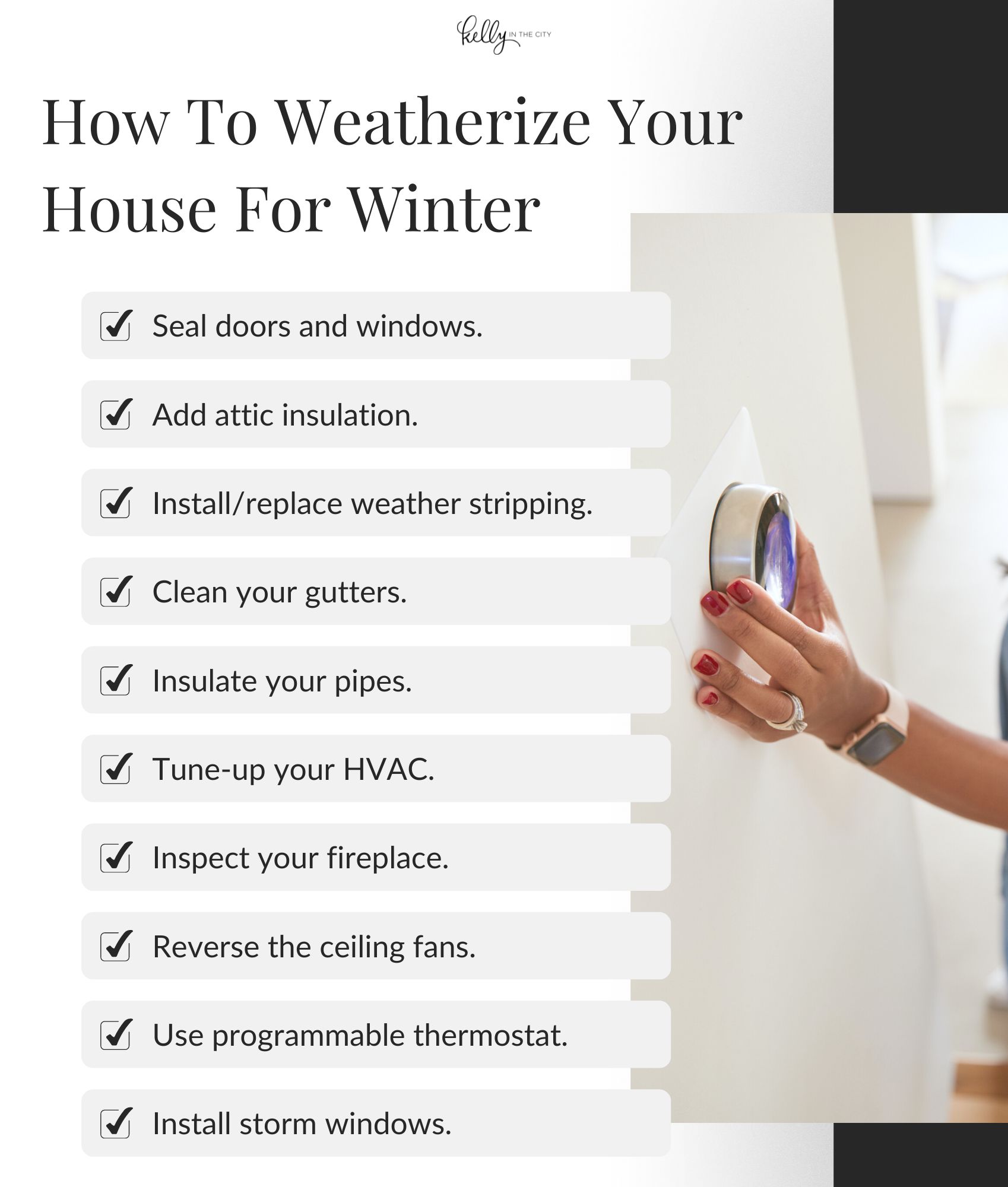Brrrr winter has arrived, which means it’s time to talk about preparing your home for the cold season. Something we have to do each and every year here in cold, windy Chicago!
To weatherize your home for winter, you’ll make repairs and improvements that are aimed at keeping cold air out while preventing heat from escaping. The good news is: there are several things you can do yourself to weatherize your home, prevent heat loss, and save energy, without needing the help of a professional.
These home weatherization tips are easy to follow and can make a significant impact on the energy efficiency of your house. And don’t worry, it’s not too late to start weatherizing. You’ll be so happy you did some January, February, and March!

How To Weatherize Your House For Winter
Seal doors and windows.
Sealing your windows and doors helps to keep air and water from getting into your house. The process involves caulking around the frame of each window and door, at the edge of the trim, except for the underside. The undersides of windows or doors are necessary escapes for moisture vapor.
Sealing your doors and windows helps to ensure that living spaces in your home stay comfortable, even when the weather outside is frightful.
Add attic insulation.
Your HVAC unit won’t be able to function optimally if your attic lacks insulation. Because hot air rises, if your attic isn’t properly insulated, you will lose a significant amount of heat to your attic. With proper insulation, the warm air will stay in the rest of your house. This not only keeps you warmer, but will decrease your heating bill. Yes, please!
There are several ways to insulate your attic. If you prefer to DIY, you can use plywood or wallboard to close off large sections of your attic where hot air is leaking through. You could also use caulk to seal the joints and holes around the pipes and ducts.
To truly see a difference, however, you may want to consider hiring someone to professionally seal your attic with products like expanding foam.
Install/replace weather stripping.
If your exterior doors have weatherstrips like door sweeps at the bottom it’s important to inspect them to ensure they’re working properly. Check the seal of your weather stripping and look for any spots where there could be air leaks. If necessary, repair or replace the ineffective weather stripping.
If you don’t have weather stripping, consider using it on your doors and windows to prevent air leaking into your home.
Clean your gutters.
When was the last time you looked at your gutters? If your gutters are clogged, they won’t drain properly and ice dams will form. Those areas where ice builds up can create water damage inside your home. You’ll want to make sure your gutters are free of leaves and other debris that may have accumulated in the gutters around your house.
Insulate your pipes.
No matter how effective your water heater is, or how often you use it, you will still want to insulate the pipes in your home. It is especially important to insulate your pipes in areas that aren’t heated, such as your garage, attic, or basement.
Pipes that aren’t insulated can potentially burst, resulting in water damage or even flooding. You can do it yourself by wrapping insulation around pipes in unheated spaces, or you can hire a handyman to do it for you.
Tune-up your HVAC.
Your HVAC system is essential to staying comfortable during the winter. When winterizing your home, you want to make sure your HVAC unit is working optimally.
You may want to hire a professional to have them inspect the major components of your unit to ensure they are working fine, but you should be OK to do the rest of the tune-up yourself.
A good place to start is with checking the refrigerant levels. Refrigerant that is either too high or too low can cause problems. Also, inspect your unit for refrigerant leakage and seal any cracks or holes you find.
You should also clean your air filters. A clogged or dirty filter will force your HVAC unit to work harder, which results in wasted energy and unnecessary costs. Keep your filters clean or replace them regularly. In the middle of winter, as well as in the middle of summer, you should try to clean your filters every 2-3 weeks and replace them every 3 months.
Inspect your fireplace.

Giving your fireplace an inspection is another important part of preparing your home for winter. There are several parts to a thorough fireplace inspection:
- Clean the fireplace to remove dust and other buildup
- Look for damage in the form of cracks, broken mortar, or loose bricks
- Check the chimney cap to see if it is still effectively keeping leaves, rain, and debris out
- Look for areas where air is getting out or coming in. Seal any air leaks and keep the damper closed when you’re not using your fireplace
- Check the dampers for any damage and clean it thoroughly to ensure it can effectively prevent heat loss
- Clean the blower if your fireplace has one
- Check the gasket to make sure it’s still in place
Reverse the direction of your ceiling fans.
You might be surprised by how many people don’t know about changing the direction of their ceiling fans. Ceiling fans aren’t only meant for cooling your home. In the winter, you can reverse the direction of your ceiling fan so that the heat rising to your ceiling is blown back down closer to where you are.
Use a programmable thermostat.
Programmable thermostats help your heating system work more efficiently. According to ENERGY STAR, you can save up to 10% on the cost of heating and cooling your home just by using a programmable thermostat. Set your thermostat to recommended temperatures so that you can stay warm while you’re at home, but save some money on the cost of heating your house while you’re away.
Install storm windows.
The purpose of storm windows is to protect your main window from the elements. They reduce heat loss, but they only work if they are fitted tight enough to limit the amount of air moving. Your storm windows should fit tightly all around the window frame, with just a small hole to allow moisture to escape.

Share your favorite tips on preparing your home for Winter!
As we ready our home for winter, I would love to hear all the ways you’re weatherizing your own house. What have you found to be most effective? Have you noticed a significant change in your energy bill? Tell us! Then head on over to the blog to hear more about everything my family is getting into as winter inches closer.














